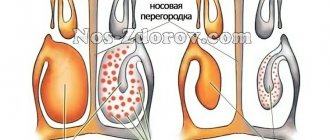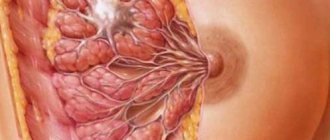Causative agents of pustules on the labia
All microorganisms that cause a rash can be divided into two groups:
- specific infection - these are pathogens of sexually transmitted diseases or Mycobacterium tuberculosis;
- nonspecific infection - representatives of transit or opportunistic flora.
By type, these can be:
- bacteria;
- fungi;
- viruses.
Much less often, pustules on the labia minora are caused by ectoparasites.
With scabies, mainly papules appear.
They are complicated by bacterial infection with the formation of pustules.
What is and ICD-10 code
Bartholin's glands are located in the lower third of the vestibule of the vagina. This is a paired organ. Its task is to produce a secretion that moisturizes the mucous membrane of the vagina and vulva, protecting the reproductive organs from infection by pathogenic flora.
Abscess does not occur in children and adolescents. Extremely rare - in the elderly. Patients with Bartholin gland pathology are women of reproductive age.
The process usually affects one of the organs. Bilateral inflammation is a consequence of a bacterial infection, most often gonorrhea.
ICD 10 code for Bartholin gland abscess is N75.1. There are true ones, involving organ tissue, and false ones, which develop due to stenosis or blockage of the duct.
Pustules on the labia due to STDs
When infected with sexually transmitted diseases, the urethra or vagina most often becomes inflamed.
But with some diseases, inflammation of the vulva is also possible.
Sometimes it occurs against the background of colpitis and urethritis.
STDs that can cause the rash include:
- candidiasis;
- herpes;
- papillomavirus infection;
- molluscum contagiosum;
- syphilitic infection.
Other pathogens are less likely to cause vulvovaginitis.
Sometimes infection with gonococci leads to the appearance of pustules.
Syphilis on the labia
Syphilitic infection produces different symptoms at different stages of the disease.
Ulcers can appear at any time.
But they are completely different.
In the classic clinical course, after infection with syphilis, a papule appears on the labia.
Women may mistake it for an abscess.
The papule quickly enlarges and ulcerates.
Erosion forms on a dense base.
It is painless and has a round shape.
Usually has a red color.
But when located on the outer surface of the labia, it often becomes covered with a brown crust.
In the case of bacterial superinfection, primary syphiloma may suppurate.
Then an abscess forms on the labia majora.
It may become painful.
Lymph nodes enlarge.
Usually with syphilis they do not provoke pain and do not have signs of inflammation.
But if a superinfection occurs, the lymph nodes become inflamed and painful.
At the second stage of the disease, rashes form on various parts of the body.
It can also occur on the labia.
Usually there are many elements.
They may be different.
The appearance of pustules (ulcers) usually indicates a severe course of syphilitic infection.
If they occur, they are found not only on the labia, but also in other areas.
Finally, in the Tertiary period, gummas and tubercles are formed.
These are large elements that cause tissue destruction.
When infected, suppuration is possible and pain appears.
Conclusion
Treating a boil takes time and responsibility. To reduce the risk of relapse, you need to undergo a medical examination by an endocrinologist and surgeon. A number of preventive measures will help protect the body from infectious infections:
- strengthening the immune system - taking vitamin complexes, hardening, maintaining the correct daily routine;
- exclusion from the diet of fatty and spicy foods;
- refusal to use tobacco and alcohol products;
- maintaining personal hygiene;
- disinfecting the skin with antiseptic agents after shaving.
A furuncle is a bacterial infection of the hair follicle. Such ulcers can appear on any part of the body. A boil on the genitals in women is accompanied by painful sensations and causes serious discomfort. An abscess should be treated carefully, since due to its location, damage to the boil can lead to infections of the genital organs.
Molluscum contagiosum on the labia
This is a viral infection.
It spreads through sexual contact.
Infects the skin.
Large nodules appear on it.
They have a depression in the center.
A white mass is released from it when pressed.
Therefore, women often confuse such elements of a rash with pustules.
In fact, there is no pus in them.
Molluscum contagiosum is a relatively harmless sexually transmitted infection because it:
- does not cause complications;
- goes away over time without treatment;
- does not provoke pain or other unpleasant sensations.
But still, most women do not like the presence of nodules.
After all, they create an aesthetic defect and can disrupt the quality of sexual life.
If a patient becomes infected with molluscum contagiosum due to immunodeficiency conditions, the nodes appear quite large and there are a lot of them.
But even with the classic course of the disease, small nodules can exist for several months.
If necessary, they can be removed.
This procedure is quick and painless.
It does not leave scars, since the nodes are localized in the very top layer of the skin.
Candidiasis on the labia
Fungal pathology very often causes inflammation of the labia.
This is one of her favorite localizations.
The causative agent is candida.
This is a family of opportunistic fungi.
In 80% of cases or more, the causative agent is candida albicans.
Less commonly, these are other fungal microorganisms.
They live in a woman's intestines and vagina.
But they are present in small quantities, so they do not cause inflammatory reactions.
Candida generally has low pathogenicity and immunogenicity.
But under certain circumstances, it provokes symptoms of vulvovaginitis.
They appear as a result:
- decreased immunity;
- hypothermia;
- unprotected sexual intercourse (exogenous infection);
- taking antibiotics;
- use of drugs that reduce immunity;
- trauma to the labia, etc.
That is, the disease manifests itself only when exposed to provoking factors.
Although sometimes it seems to women that the pathology appeared without a reason, because it is not always possible to establish these factors.
In most cases, candidiasis is mild.
Spots, papules, and white plaques form on the labia.
Ulcers appear only in severe cases.
It is typical for:
- HIV-infected;
- suffering from diabetes;
- taking immunosuppressants, cytostatics, etc.
That is, for women whose immunity is severely weakened or their blood circulation is impaired.
In this case, a pustular rash is observed.
It is always combined with other symptoms.
The skin of the labia turns red and swells.
White or gray plaques with a sour odor appear on it.
Painful erosions and cracks may appear.
Drug treatment
At the maturation stage, unaffected areas near inflammation should be treated with antiseptic solutions:
- iodine;
- brilliant green;
- fucorcin;
- Miramistina.
Important! Before and after contact with a boil (with a wound or purulent head), you must wash your hands with antibacterial soap.
A bandage with a hypertonic solution (NaCl) is applied to the opened boil on the labia. It absorbs pus and pathogenic microbes. Instead of this composition, you can apply a tampon with Vishnevsky liniment or ichthyol ointment. The smell of these medicines is unpleasant and quite pungent, but the pus is drawn out quickly and painlessly.
After removing it, apply a bandage with an ointment that has an antibacterial effect. These include tetracycline, gentamicin, syntomycin. To speed up the regeneration of the skin and prevent the appearance of a dense scar, Solcoseryl is applied.
To prevent inflammation of adjacent areas of the skin of the labia, it is necessary to carry out daily wiping with a 2% alcohol solution of salicylic acid or camphor alcohol.
Important! In case of purulent-inflammatory processes, it is strictly not recommended to apply warm compresses to the affected area, since elevated temperatures contribute to the proliferation of pathogenic bacteria and aggravation of the condition.
In addition to local therapy, the doctor will prescribe antibiotic therapy. For effective treatment, the patient takes broad-spectrum antibiotics, such as:
- Doxycycline;
- Azithromycin;
- Ceftriaxone;
- Penicillin;
- Gentamicin.
Along with them, the specialist prescribes immunostimulating drugs, lactobacilli, bifidobacteria and vitamins.
Important! You cannot squeeze, scratch, or open a boil in an intimate place yourself, as this can spread the infection throughout the body.
HPV on the labia
Purulent inflammation is not typical for human papillomavirus infection.
With this disease, condylomas are formed.
But they can be infected with secondary bacterial flora.
In this case, the condyloma becomes inflamed.
It really turns into a small abscess.
By itself, it does not promise big problems.
But the fact of infection with papillomavirus requires examination of the patient.
After all, cervical cancer often develops from this infection.
Therefore, every woman with detected HPV is subject to control.
She undergoes tests for the type of papillomavirus and smears for oncocytology.
According to indications, colposcopy and sometimes a biopsy of the cervix are performed.
Possible reasons
The Bartholin gland is the largest of all, located in the vestibule of the vagina. It becomes inflamed quite rarely; bartholinitis itself, according to statistics, is found in 2 women out of 100. Usually, a combination of different factors is necessary for the onset of the pathological process. Sometimes, however, one is enough. The causes of the disease may be:
- Weakened immunity. From time to time the situation is aggravated by autoimmune reactions. Doctors also note an increased likelihood of developing bartholinitis in this condition of the body;
- Relatively recent gynecological diseases. The causative agents of gonorrhea and other infections can enter the gland through the ducts;
- Numerous abortions, especially poorly performed ones. Various surgical interventions and diagnostic procedures can also pose a threat;
- Vaginal dysbiosis. This painful condition negatively affects the body's defenses as a whole, in addition, it weakens the natural defenses of the pelvic organs. The number of pathogenic bacteria inside the vagina increases. And some of them can get inside the gland in question in order to cause inflammation.
- Poor hygiene. Rarely changing gaskets along with lack of regular washing, accumulation of dirt - all this can lead to a very large number of pathogenic bacteria in this area;
- The underwear is too tight. Injury to the area under discussion, diaper rash and chafing together can lead to bartholinitis;
- Too hard sex. The reasons here are similar to those stated in the previous paragraph;
- Frequent change of sexual partners. Promiscuous sex life in itself does not cause disease, but it significantly increases the risk of infection, and also weakens the immune system;
- Severe stress and hormonal fluctuations. They affect the woman’s immune status, which, in turn, greatly increases the risk.
Herpes on the labia
In the classic course, a herpetic infection does not form pustules, but blisters.
But bacterial infection of the vesicles occurs quite often.
In this case, dozens of small pustules form on the labia.
Herpes is an infection that is transmitted by contact.
If herpetic rashes form on the genitals, this indicates that the person became infected during sexual intercourse.
The incubation period lasts about 1 week.
Then, blisters form on those areas of the woman’s skin that were in contact with herpetic rashes on her partner.
They appear on the labia, perineum, and vagina.
Initially, the bubbles are filled with a clear liquid.
In some patients, secondary flora is added.
Then the contents of the bubbles become cloudy.
It turns white.
Associated symptoms:
- itching and pain at the site where pustules appear;
- enlarged and painful lymph nodes;
- redness of the skin and swelling in the area where the rash is located;
- systemic manifestations of infection (fever, headache, myalgia).
Herpes goes away quite quickly.
Even without treatment, symptoms go away after 2-3 weeks, and with therapy, even faster.
But later the virus remains in the body.
From time to time it causes relapses.
As a rule, exacerbations are milder than the initial episode of infection.
This is due to the fact that antibodies are formed against the herpes virus, which inhibit its replication.
Severe herpes with the formation of ulcers is typical primarily for women with immunodeficiency conditions.
What is the danger?
The danger of a boil is that it can cause complications if it is untimely or incorrectly treated, as well as if you squeeze out the abscess yourself or do not follow the rules of antiseptic treatment.
What complications can a boil in the intimate area lead to:
- furunculosis - the formation of multiple ulcers at different stages of maturation. Foci of inflammation of the hair follicles occur constantly, due to which the body is subjected to severe intoxication;
- phlegmon - a purulent process in the subcutaneous fatty tissues. The disease progresses rapidly due to the absence of a restrictive capsule and spreads through different layers of the skin, muscles and internal organs; we wrote about how it can be cured in this material;
- lymphadenitis - inflammation of the lymph nodes mainly in the groin area;
- phlebitis - an inflammatory process in the walls of venous vessels;
- sepsis - the spread of infection through the bloodstream with further purulent inflammation throughout the body. The disease is serious, difficult to treat and often fatal.
Do you think it is possible to get chickenpox a second time? Find the correct answer to the question in this publication.
Carbuncle - what is it? What are the reasons for its occurrence? How is it different from a boil? How and with what is it treated? Our article will talk about this.
Boils on the labia
This disease usually develops against the background of folliculitis.
An extensive purulent focus appears.
This large abscess is painful.
The skin over it is red.
Gradually it becomes cyanotic.
There may be a feeling of warmth upon palpation.
Fluctuation is noted - fluctuation of the liquid inside the formation.
A boil is dangerous because it can transform into a carbuncle.
These are several boils connected together.
An abscess can develop here - a focus of purulent inflammation surrounded by a dense capsule.
In severe cases, phlegmon develops.
It is characterized by the spread of inflammation to fatty tissue with its necrosis and purulent melting.
Boils carry a risk of complications.
They lead to the formation of synechiae and fusion of the labia.
The infection can spread to the genitals, urethra, and bladder.
Often the patient requires surgery for this disease.
Features of treatment and opening of an abscess
The method of managing the patient depends on the severity, form of the inflammatory process, depth of tissue damage, and medical history.
Surgery for Bartholin's gland abscess is performed under local anesthesia or general anesthesia. Intervention in an acute process is urgent, in a recurrent course it is planned after the acute condition is relieved.
Pregnancy is not a contraindication for surgery for purulent inflammation of the reproductive organs.
Treatment methods for abscess of Bartholin glands:
- Wide dissection - a technique used for false and true abscesses. The mucous membrane is dissected to a width of 6 cm. The purulent focus is sanitized. Drainage is installed. In the postoperative period, the cavity is washed with antiseptic solutions for 7 days. A relapse of the disease is possible.
- Dissection with installation of a catheter to form a new anastomosis is indicated for unilateral empyema. The incision on the mucosa is 3–5 mm. The abscess is drained and treated with antiseptics. At the next stage, a catheter is inserted into the cavity. After 2 months, the structure is removed.
- Marsupialization is the opening of a Bartholin gland abscess with suturing of the cyst capsule to the vulvar mucosa to form a new anastomosis. The operation is performed for empyema with several small abscesses in the vestibule area of the vagina.
- Organ removal is performed under general anesthesia. Indicated for recurrent disease. It is carried out when other treatment methods are ineffective. There is a danger of massive bleeding. The result of successful implementation is the absence of relapse of the disease.
At the recovery stage, massive antibiotic therapy is indicated; in severe cases, intravenous drip administration of saline solutions and detoxification treatment. Sutures are placed after stopping the purulent process in the inflamed Bartholin gland.
Bartholinitis on the labia
There are Bartholin glands in the labia.
If they become infected, an abscess may form.
Bartholinitis usually develops as a complication of colpitis.
As a result of edema, the excretory ducts of the large vestibular gland close.
The outflow of the secretion becomes impossible.
It accumulates inside.
This is how a retention cyst is formed.
If the secretion stagnates for a long time, it can become infected with bacterial flora.
As a result, an abscess appears - a limited purulent cavity.
In fact, it is a large abscess on the labia, on the inner side.
Main symptoms:
- pain that increases with defecation, sitting, palpation of the abscess;
- asymmetry of the genital organs due to swelling on one side;
- increase in body temperature.
The abscess may spontaneously open with the release of pus.
This outcome carries a risk of complications, so usually a woman in this condition is hospitalized in a hospital.
Treatment
Treatment for Bartholin gland abscess is surgical.
Technique for opening an abscess. Preparation of the surgical field is usual. The hair on the external genitalia is shaved off, the vagina is washed with some kind of disinfectant solution (potassium permanganate solution, etc.) and, to avoid contamination with pus, it is tamponed with a strip of sterilized gauze. For pain relief, we usually use ether or chlorethyl stunning. The incision area is lubricated with iodine tincture. The incision should be made large and brought to the lower pole of the abscess, otherwise there will be pockets in which pus will accumulate, resulting in a purulent fistula that does not heal for a long time. An incision is made at the site of clearest fluctuation, where the tissue covering the abscess is thinnest. After the pus has drained, the abscess cavity is sprinkled with white streptocide or wiped with a small tupper moistened with iodine tincture; then a strip of gauze or a thin rubber tube is inserted into the cavity to prevent the hole from closing prematurely. At the end of the operation, the end of the gauze strip is removed, and after a day it is completely removed. A pad of gauze and cotton wool is placed in front of the vulva to absorb the pus flowing from the wound. It is unnecessary to apply a bandage. The drainage tube is replaced after 2 days with a fresh gauze strip or a drainage tube of a smaller diameter. It is necessary to ensure that the hole does not stick together before the granulations fill the abscess cavity. Vishnevsky ointment gives satisfactory results. Gauze turunda soaked in Vishnevsky ointment can be applied immediately after incision of the Bartholin gland abscess.
If the inflammation recurs or a purulent fistula tract that does not heal for a long time remains, then radical surgery is necessary, i.e., removal of the gland along with its excretory duct.
Tests for pustules on the labia
Upon examination, the doctor may suspect an infectious process based on symptoms alone.
But he doesn’t know what caused the abscess.
This requires tests.
During their implementation, the doctor is able to identify the causative agent of the infectious disease.
This information allows you to select effective etiotropic treatment.
Without knowing the causative agent, drugs have to be prescribed at random.
This approach is not always justified.
After all, if it turns out that the antibiotic used does not work, this can lead to complications.
If a patient is diagnosed with an abscess on the labia minora, she first submits a smear for microscopic examination.
Often it shows signs of inflammation.
Some STD pathogens or opportunistic microflora may be detected.
Species identification of microorganisms is carried out using:
- sowing on flora;
- PCR for sexually transmitted infections;
- blood test for syphilis.
For sowing, material is taken from the elements of the rash (pustules).
It is placed in a nutrient medium.
It contains the necessary nutrients, and the thermostat maintains the optimal temperature for bacteria.
Therefore, if bacteria are present in clinical material, they form colonies.
Microorganisms are identified and their number is estimated.
For the most numerous bacteria, special tests are used to assess their sensitivity to various antibiotics.
PCR is used to identify pathogens of specific infections.
Using this method, DNA fragments of bacteria or viruses are detected.
Medical reference books
Bartholinitis
general information
Bartholinitis
is an inflammation of the large (Bartholin) gland of the vestibule of the vagina. Most often, this disease is one-sided and is usually caused by various microorganisms - gonococci, staphylococci, E. coli, trichomonas, etc. Bartholinitis occurs in the absence of genital hygiene, decreased immunity, vaginal dysbiosis, and sexually transmitted diseases. The infection penetrates the excretory duct of the gland, clogging it; A false abscess (cyst) forms. In some cases, inflammation spreads to the parenchyma, purulent exudate fills the lobules of the gland, and a true abscess occurs. Sometimes suppuration is not observed, although the gland remains dense and somewhat enlarged, but after some time the inflammatory process may resume with complications. With spontaneous opening of the abscess, with the expulsion of purulent contents, the acute symptoms of inflammation decrease and the condition improves significantly. However, this is not an indicator of cure - after opening, a relapse usually occurs, and bartholinitis can become chronic.
Etiology and pathogenesis
The causes of bartholinitis are: 1. Specific pathogens: • gonococci;
• Trichomonas. 2. Nonspecific pathogens: • aerobic gram-positive bacteria of the genus Streptococcus, Staphylococcus; • aerobic gram-negative bacteria of the genus Escherichia. Mechanisms of disease development
When an infection enters the excretory duct of the large gland of the vestibule of the vagina, inflammation develops with the release of mucopurulent secretion. Swelling of the external opening of the duct leads to its obliteration, retention of gland secretions in its ducts with the formation of a retention cyst. When infection penetrates the parenchyma of the gland and surrounding tissue, a true abscess develops. When the contents of the cyst become infected and suppurate, a false abscess is formed. When the inflammatory process becomes chronic, the walls of the excretory duct of the glands become unevenly compacted, which is characteristic of nodular canaliculitis, more often observed with gonorrheal infection.
Clinical picture
The main clinical signs of acute bartholinitis are manifested in pain in the middle third of the labia majora and an increase in body temperature. On examination, the presence of hyperemia and swelling of the labia majora in the area of the gland is noted. With chronic bartholinitis,
clinical manifestations are often absent.
During an exacerbation of the process, enlargement, swelling, and thickening of the labia majora on the affected side are observed; pain at rest and on palpation. Complications A true abscess (acute period)
is characterized by inflammation of the Bartholin gland tissue itself. It occurs acutely, with chills and increased body temperature, pain in the area of the labia majora and minora at rest, aggravated by walking, as well as in the area of the inguinal lymph nodes. Upon examination, swelling of the labia majora and minora and their redness are detected. Objective examination data indicate pain upon palpation of the labia majora and minora, as well as upon palpation of the inguinal lymph nodes.
Classification and examples of diagnosis formulation
According to the clinical course, bartholinitis is divided into: • acute; • chronic; • false abscess; • true abscess. Based on their origin, the following false abscesses of the gland are distinguished: • primary (due to purulent canaliculitis); • secondary (due to suppuration of a retention cyst).
Diagnostics
• Study of anamnesis.
• Examination using mirrors. • Colposcopy. • Bimanual gynecological examination. • Oncocytological examination of smears. • Rectal examination and deep palpation of the abdomen. • Blood test for syphilis, HIV. • Bacterioscopic examination of discharge from the vagina, cervical canal, urethra. • Determination of HSV and chlamydia antigens in material from the cervical canal or urethra using ELISA or PCR. • Determination of Ig M to HSV, Ig A to chlamydia in blood serum. • Determination of Ig G to HSV, chlamydia (test of paired sera with an interval of 2 weeks). Differential diagnosis
Acute bartholinitis is usually differentiated from the following diseases: • boil of the labia majora; • cysts of the longitudinal duct (Gartner's canal); • tuberculosis of the arch of the pubic bones; • Bartholin gland cancer.
Treatment
A timely visit by a patient to a gynecologist if even a small and slightly painful lump appears at the entrance to the vagina will prevent the development of the disease and possible complications requiring surgical intervention. Conservative treatment of bartholinitis can be successful only in the initial stages of the disease. Bed rest is recommended, analgesic and antibacterial therapy is carried out. If the condition worsens (an abscess occurs), surgical treatment is indicated, which is carried out in a day hospital or during hospitalization in the surgical department.
Surgical treatment of Bartholin gland abscess
It is necessary to open the abscess with subsequent drainage so that the edges do not stick together in the coming hours and new suppuration of the gland does not occur, or marsupialization is performed (suturing the edges of the wall of the opened cavity to the edges of the surgical wound).
An abscess may spontaneously rupture into the area of the vaginal vestibule, labia majora, vagina, or rectum. Rapid closure of the hole also leads to relapse of the disease with the formation of an abscess, retention cyst or chronic bartholinitis. Bartholin gland cyst
Treatment is aimed at restoring the function of the gland. For this purpose, preliminary preparation is carried out: antibacterial, restorative, immunomodulatory therapy; local treatment. Then the cyst is removed (during the period of remission).
Performance criteria
Positive dynamics of gynecological and laboratory research data.
Prevention
Prevention of bartholinitis consists of maintaining personal hygiene, avoiding casual sexual intercourse, and timely treatment of inflammatory processes of any location. To prevent relapses, it is necessary to remove the cyst capsule.
How to anoint pustules on the labia
Antibiotics are often used externally.
Erythromycin or tetracycline ointment is used.
Levomekol can be used - it contains chloramphenicol.
These medications will work if the pustules have formed as a result of a bacterial infection.
If it was caused by fungal flora, antimycotics are used.
This is miconazole or clotrimazole.
In the case of herpes, use acyclovir gel.
Local treatment can be both the basis of therapy and an addition to it.
Pustules on the labia: what pills to take?
You should only take medications that are prescribed by your doctor.
You can't take antibiotics at random.
They are selected based on the isolated pathogen.
In this case, the doctor can take into account the antibiogram data, which are given in the results of bacteriological culture.
Tetracyclines, macrolides, nitroimidazoles, cephalosporins and other drugs can be used in various situations.
For pustules of fungal origin, take fluconazole or itraconazole in tablets.
If the cause is herpes, valacyclovir is prescribed.











